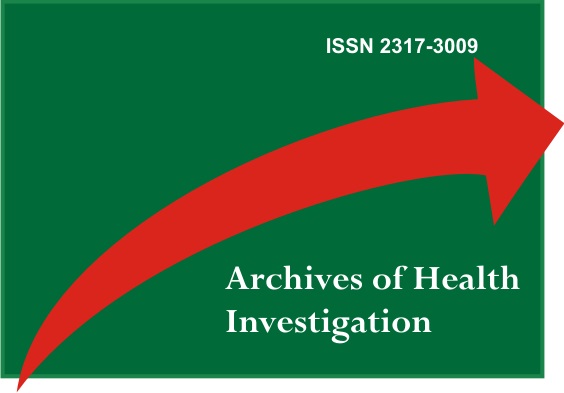Effectiveness of Home Disinfection of Dental Brushes through Chemical Methods
DOI:
https://doi.org/10.21270/archi.v11i5.5543Palavras-chave:
Toothbrushing, Disinfection, ContaminationResumo
Oral hygiene gained a great deal of space in the daily lives of the population, with that the concern with the correct way to perform the hygiene and storage of the toothbrush. Bacterial plaque is one of the main causative agents of caries and periodontal disease, along with bacteria, fungi and viruses that are found within the oral cavity. The accumulation of biofilm and the lack of oral hygiene provide an ideal environment for the proliferation of microorganisms, increasing the risk of causing these diseases. In this regard, the toothbrush will serve as an important tool for removing plaque and these organisms. However, right after the first use of the brush, these microorganisms become lodged on the surface of the brush. In order to reduce the number of microorganisms, physical and chemical methods have emerged for disinfecting toothbrushes. Thus, this study aims to analyze the effectiveness of home disinfection of toothbrushes using chemical substances. This is an in vitro laboratory study in which brush hygiene was evaluated by immersion and spraying (n=3), with chlorhexidine, hydrogen peroxide, essential oils and distilled water, as a negative control, to serve as a comparison for microbial growth in Brain Heart Infusion Broth (BHI) culture medium. The result was evaluated according to the transparency of the culture medium following the McFarland turbidity scale. The result of the experiments was that the group by immersion of essential oils showed the best result in the absence of bacterial growth, followed by chlorhexidine and then hydrogen peroxide. The group by spraying both substances was the one that proved to be the most flawed, with a high rate of bacterial growth. Thus, essential oils were the most effective substance, however, none of the methods proved to be totally efficient in combating Streptococcus mitis.
Downloads
Referências
Menezes MLFV, Macedo YVG, Ferraz NMP, Matos KF, Pereira RO, Fontes NM et al. A importância do controle do biofilme dentário: uma revisão da literatura. Revista Eletrônica Acervo Saúde / Electronic Journal Collection Health. 2020;sup(55):e3698.
Gonçalves GH, Silva JDS, Lopes LT, Moraes-Filho IM, Cangussu DDD, Lima JAS. Contaminação, meios de desinfecção e armazenamento da escova dental: revisão de literatura. Rev Inic Cient e Ext. 2019;2(4):219-22.
Ferreira CA, Savi GD, Panatto AP, Generoso JS, Barichello T. Microbiological evaluation of bristles of frequently used toothbrushes. Dental Press J Orthod. 2012;17(4):72-6.
Queiroz FS, Nóbrega CBC, Costa LED, Reul MA, Abreu RSA, Leite MS. Avaliação do perfil de armazenamento e descontaminação das escovas dentais. Rev Odontol UNESP. 2013;42(2):89-93.
Queiros ECF, Passos MAN. Aspectos de contaminação e descontaminação das cerdas de escovas dentais. Aspects of contamination and decontamination of dental brush bristles. Revista Ciências e Odontologia. RCO. 2019;3(1):1-5.
American Dental Association – ADA. Toothbrush care: cleaning, storage and replacement [Internet]. Chicago: Council on Scientific Affairs; 2011. Available in: http://www.ada.org/1887.aspx.
Rezende MCRA, Lopes MRANE, Gonçalves VM, Capalbo LC, Oliveira JAG, Fajardo RS. Descontaminação de escovas dentárias: métodos e eficácia. Arch Health Invest. 2015;4(1):50-7.
Chaves RAC, Ribeiro DML, Zaia JE, Alves EG, Souza MGM, Martins CHG. Mestriner, SF. Avaliação de soluções antibacterianas na descontaminação de escovas dentais de pré-escolares. Rev Odontol UNESP. 2007;36(1): 29-33.
Anand PJS, Athira S, Chandramohan S, Ranjith K, Raj VV, Manjula VD. Comparison of efficacy of herbal disinfectants with chlorhexidine mouthwash on decontamination of toothbrushes: An experimental trial. J Int Soc Prev Community Dent. 2016;6(1):22.
Basman A, Peker I, Akca G, Alkurt MT, Sarikir C, Celik I. Evaluation of toothbrush disinfection via different methods. Braz Oral Res. 2016;30:e.6.
Francisco GR, Marco G, Siliano PR. Isolamento e identificação de bactérias presentes em escovas dentais. Rev Cient Saúde. 2017;1(2).
Zão EJR, Silva MAM, Alves MU. Desinfecção e armazenamento de escovas dentais: avaliação da prática realizada por acadêmicos do curso de odontologia da Universidade Severino Sombra. Vassouras, Rio de Janeiro. Rev Pró-UniverSUS. 2011;2(1):53-64.
Neves ETB, Monteiro ELT, Silva DR, Perazzo MF, Lima ZN, Cavalcanti AL. In vitro analysis of toothbrushes' disinfection by antimicrobial activity substances. Arch Health Invest. 2018;7(10):415-19.
Nascimento C, Sorgini MB, Pita MS, Fernandes FHCN, Calefi PL, Watanabe E et al. Effectiveness of three antimicrobial mouthrinses on the disinfection of toothbrushes stored in closed containers: a randomized clinical investigation by DNA Checkerboard and Culture. The Gerodontology Society and John Wiley & Sons A/S, Gerodontology. 2014;31:227-36.
Araújo RJC, Azevedo AA, Castro IMC, Trindade JP. Contaminação, desinfecção e acondicionamento de escovas dentais. Rev Bras Odontol Mil. 2012;29(1/2):44-54.
Costa JO, Carvalho FS, Carvalho CAP. Desinfecção e acondicionamento de escovas dentais: conhecimento e atitudes de acadêmicos de enfermagem. Arch Health Invest. 2017;6(9):418-22.
Ralephenya TRMD, Molepo J, Molaudzi M, Volchansky A, Shangase SL. Contamination of used toothbrushes and their decontamination with disinfecting agents. SADJ. 2020;75(9):478-84.


